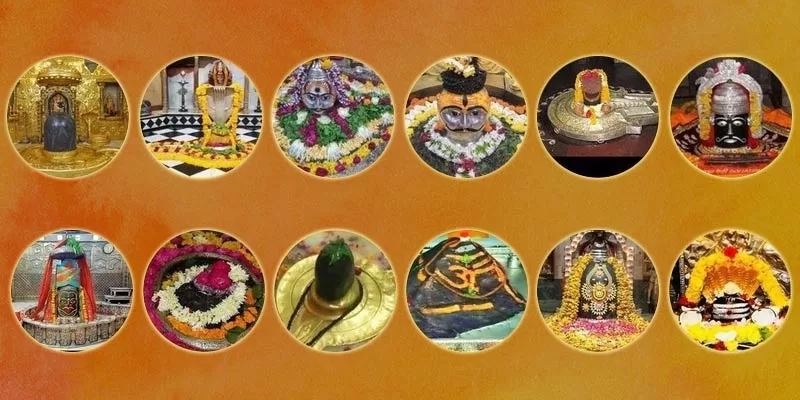India, a land of diverse cultures and rich traditions, is known for its spiritual heritage. Among the countless sacred sites scattered across the country, the twelve Jyotirlingas hold a special place in Hinduism. These Jyotirlingas are revered as manifestations of Lord Shiva and are significant pilgrimage destinations for millions of devotees. In this article, we will explore each of the 12 Jyotirlingas, their unique stories, and the importance they hold in the hearts of the faithful.
How Many Jyotirling are There in India
In India, there are 12 sacred Jyotirlingas. It is believed that Lord Shiva made his first earthly manifestation during the Aridra Nakshatra night, which is why these Jyotirlingas hold special reverence. These divine manifestations do not have a distinctive appearance, and some believe that, at an advanced spiritual level, they can appear as columns of fire piercing through the Earth.
Originally, there were 64 Jyotirlingas, but 12 are particularly revered as highly auspicious and holy. Each of these 12 Jyotirlinga temples in India is named after the presiding deity and is considered a unique manifestation of Lord Shiva. The central image in all of these lingas is the “lingam,” symbolizing the eternal nature of Lord Shiva, representing both the beginning and the end, like an infinite pillar.
12 Jyotirlingas in India with Their Location
Kedarnath Jyotirlinga in Rudraprayag
Kedarnath Jyotirlinga is nestled in the picturesque Garhwal region of Uttarakhand. It is believed to be the place where Lord Shiva absolved the sins of the Pandavas. The temple, set amidst the stunning Himalayan peaks, is a testament to devotion and spirituality.
Somnath Jyotirlinga in Gir
Somnath Jyotirlinga, situated in the state of Gujarat, is a symbol of resilience and unwavering faith. It has been reconstructed several times after being demolished, making it a true embodiment of the undying spirit of devotion.
This temple holds great religious significance and has served as a pilgrimage destination for centuries. Moreover, it is celebrated for its remarkable architectural beauty. Despite facing destruction multiple times, its repeated reconstruction stands as a testament to the unwavering faith and devotion of its followers. Set against the vast backdrop of the Arabian Sea, the tranquil ambiance of Somnath provides both pilgrims and tourists with a divine and serene experience.
Mahakaleshwar Jyotirlinga in Ujjain
Located in Ujjain, Mahakaleshwar Jyotirlinga is known for its fascinating legend associated with the demon King Ravana. The temple is famous for its Bhasma Aarti, a ritual where ash from the Lord’s idol is distributed to devotees.
Omkareshwar Jyotirlinga in Khandwa
Omkareshwar Jyotirlinga, located on an island in the Narmada River, is a serene and spiritual destination. The island’s shape resembles the sacred symbol ‘Om,’ adding to its significance.
Kashi Vishwanath Jyotirlinga in Varanasi
Varanasi, one of the oldest living cities in the world, is home to Kashi Vishwanath Jyotirlinga. The temple stands as a testament to the spirituality and cultural richness of the city.
Bhimashankar Jyotirlinga in Maharashtra
Nestled in the Sahyadri range of Maharashtra, Bhimashankar Jyotirlinga is not only a place of devotion but also a paradise for nature lovers with its lush greenery and wildlife.
Trimbakeshwar Jyotirlinga in Nasik
The origin of the sacred Godavari River is believed to be at Trimbakeshwar Jyotirlinga in Maharashtra. Pilgrims visit to pay their respects to Lord Shiva and seek blessings.
Ghrishneshwar Jyotirlinga in Aurangabad
Grishneshwar Jyotirlinga in Ellora, Maharashtra, is known for its captivating architectural beauty. It is associated with the tale of a devout woman who overcame adversity through her unwavering devotion.
Ramanathaswamy Jyotirlinga in Rameshwaram
Located in Rameswaram, Tamil Nadu, Ramanathaswamy Jyotirlinga is deeply connected to the epic Ramayana. The temple’s architecture and the sacred water tanks within it are awe-inspiring.
Vaidyanath Jyotirlinga in Deoghar
Vaidyanath Jyotirlinga in Deoghar, Jharkhand, is believed to have the power to heal ailments. Devotees flock to this temple seeking relief from their physical and spiritual afflictions.
Nageshwar Jyotirlinga in Dwarka
Dwarka’s Nageshwar Jyotirlinga is unique in that it is located amidst the sea. The temple is associated with the legend of a demon who was vanquished by Lord Shiva as Nageshwar.
Mallikarjuna Jyotirlinga in Srisailam
Located in Andhra Pradesh, Mallikarjuna Jyotirlinga symbolizes the divine union of Lord Shiva and Goddess Parvati, offering a unique perspective on the deity.
Aundha Nagnath – The Reclusive Jyotirlinga
Aundha Nagnath Jyotirlinga in Hingoli, Maharashtra, is relatively lesser-known, providing a peaceful and contemplative atmosphere for devotees.
Significance of the 12 Jyotirlingas
The 12 Jyotirlingas collectively symbolize the omnipresence and omnipotence of Lord Shiva. Pilgrims embark on a journey to seek the blessings of the divine and to attain spiritual enlightenment. These sacred shrines are not only places of worship but also centers of cultural significance, reflecting the rich heritage of India.
Modern Pilgrimage and Tourism
In recent times, the Jyotirlingas have attracted not only devout pilgrims but also tourists interested in exploring India’s religious and cultural diversity. To accommodate the influx of visitors, infrastructure and facilities have improved, making the journey more accessible and comfortable.
Conclusion
The 12 Jyotirlingas in India are not just places of religious significance but also cultural treasures that offer a glimpse into the deep-rooted spirituality of the country. These sacred shrines continue to draw people from all walks of life, reaffirming the enduring appeal of Indian spirituality and heritage.
FAQs
Q1. What is the significance of Jyotirlingas in Hinduism?
Jyotirlingas are considered the most sacred shrines dedicated to Lord Shiva. They represent his divine light and are revered by millions of devotees.
Q2. Are there any specific rituals associated with visiting Jyotirlingas?
Yes, there are various rituals and prayers that pilgrims perform when visiting these shrines, such as offering flowers, incense, and performing abhishekam (ceremonial bathing) to the lingam.
Q3. Can non-Hindus visit Jyotirlingas?
Yes, Jyotirlingas are open to people of all faiths and backgrounds. Visitors are expected to show respect and follow the temple’s rules and customs.
Q4. Which Jyotirlinga is the most visited and why?
Kashi Vishwanath in Varanasi is among the most visited Jyotirlingas due to its historical and cultural significance in Hinduism.
Q5. Are there specific dates or festivals when it is best to visit the Jyotirlingas?
Mahashivratri is one of the most auspicious times to visit the Jyotirlingas. Many devotees also visit during the Shravan month as it is considered particularly sacred.

